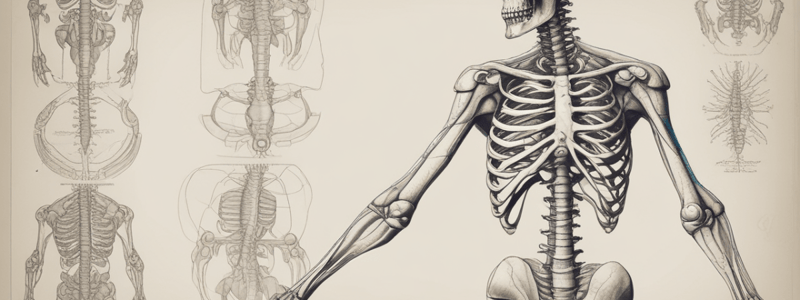Podcast
Questions and Answers
Which type of bone is described as longer than it is wide?
Which type of bone is described as longer than it is wide?
- Long bones (correct)
- Short bones
- Flat bones
- Curved bones
What is the primary function of short bones?
What is the primary function of short bones?
- Allow some movement and provide stability (correct)
- Support the weight of the body
- Connect with tendons
- Protect organs
Which bones are considered the most important for respiration?
Which bones are considered the most important for respiration?
- Limbs
- Spine
- Skull
- Ribs (correct)
Which type of muscle is involuntary and found in the stomach?
Which type of muscle is involuntary and found in the stomach?
What function is NOT associated with the skeletal system?
What function is NOT associated with the skeletal system?
Flashcards are hidden until you start studying
Study Notes
Types of Bones
- Long bones are characterized by being longer than they are wide, and they play a crucial role in supporting the body's weight and facilitating movement.
- Short bones, which are almost cube-shaped with equal proportions, provide stability and allow for some movement.
- Curved bones are thin and slightly curved, and their primary function is to protect organs.
Functions of Bones
- Bones provide protection for internal organs, such as the brain, which is protected by the skull, and the heart and lungs, which are protected by the ribs and spine.
- Bones facilitate movement by serving as points of attachment for muscles.
- Bones also serve as storage and supply sites for red and white blood cells, which are produced in the bone marrow.
Key Bones
- The skull provides protection for the brain.
- The ribs protect internal organs, support the upper body, and facilitate respiration.
- The spine provides support and protection for the spinal cord and surrounding organs.
- The limbs enable movement and support the body.
Types of Muscles
- Skeletal muscles are attached to bones by tendons and are voluntary, meaning they can be controlled consciously.
- Smooth muscles, found in the stomach, intestines, and blood vessels, are involuntary, meaning they operate without conscious control.
- Cardiac muscles, found in the heart, are also involuntary and play a crucial role in maintaining cardiac function.
Studying That Suits You
Use AI to generate personalized quizzes and flashcards to suit your learning preferences.



